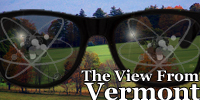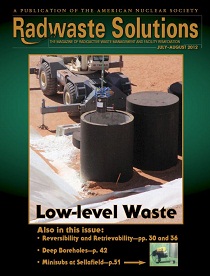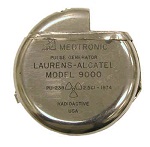Doel-3 in Belgium reports possible pressure vessel flaw
Findings could be significant for other reactors

A message from Electrical Builders, Ind.
America’s Top Performing Nuclear Plants Rely on Electrical Builders, Industries to Expand and Extend the Life of Their Critical Electrical Assets
Findings could be significant for other reactors
This past week, I had the privilege of participating in the Nuclear Technology Workshop for Teachers in Charlotte, N.C. The all-day event was part of the International Youth Nuclear Congress (IYNC)/North American Young Generation in Nuclear (NA-YGN) Public Information Day, and it had a great turnout-about 50 area science teachers were in attendance.
 On Tuesday, August 7, I attended a book tour event sponsored by a New England anti-nuclear group. The event's title that first appeared on the group's website was "Fukushima: Nuclear Power's Gift to the Planet." By the end of the four-state book tour, the title had been changed to match the book, "The Devil's Tango: How I Learned the Fukushima Step by Step" (publisher's website), by Cecile Pineda. As stated during the presentation, the book tour was planned around August 6, the 67th anniversary of the Hiroshima bombing in World War II. Pineda's presentation contained all the standard anti-nuke issues, and a few new wrinkles as well.
On Tuesday, August 7, I attended a book tour event sponsored by a New England anti-nuclear group. The event's title that first appeared on the group's website was "Fukushima: Nuclear Power's Gift to the Planet." By the end of the four-state book tour, the title had been changed to match the book, "The Devil's Tango: How I Learned the Fukushima Step by Step" (publisher's website), by Cecile Pineda. As stated during the presentation, the book tour was planned around August 6, the 67th anniversary of the Hiroshima bombing in World War II. Pineda's presentation contained all the standard anti-nuke issues, and a few new wrinkles as well.
The 117th Carnival of Nuclear Energy Bloggers is up at Next Big Future
Even before its successful landing earlier this week, NASA's Mars Science Laboratory was already sending back important scientific data-about the radiation exposure that astronauts might face during a mission to the Red Planet.
The American Nuclear Society's Utility Working Conference and Vendor Technology Expo wrapped up yesterday in Hollywood, Fla. The annual executive conference is attended by hundreds of professional nuclear operators, vendors, and regulators in a format that promotes the open sharing of ideas.
 The July/August issue of Radwaste Solutions is available in hard copy and electronically for subscribers (click "subscribers" link in left column). This issue features articles on low-level radioactive waste management, in addition to coverage of the technology and policy of high-level radioactive waste management.
The July/August issue of Radwaste Solutions is available in hard copy and electronically for subscribers (click "subscribers" link in left column). This issue features articles on low-level radioactive waste management, in addition to coverage of the technology and policy of high-level radioactive waste management.
I've been fascinated by nuclear batteries-also known as radioisotope thermal generators or RTGs-since I first saw a pacemaker battery in an exhibit at the Maryland Science Museum. As my wife and children will testify, I a m one of those slow moving people at museums who insists on reading nearly every placard under every exhibit. I'll never forget my feeling of wonder as I found out that 1/200th of an ounce of plutonium-238 could provide sufficient heat to that tiny battery to make it produce a continuous electrical current sufficient to run a heart pacemaker.
m one of those slow moving people at museums who insists on reading nearly every placard under every exhibit. I'll never forget my feeling of wonder as I found out that 1/200th of an ounce of plutonium-238 could provide sufficient heat to that tiny battery to make it produce a continuous electrical current sufficient to run a heart pacemaker.
The nuclear-powered roving robotic laboratory Curiosity touched down early on August 6, and is beaming back images while undergoing system checks. The Curiosity landing has generated worldwide interest, including interest in its plutonium power source.
Worldwide energy needs will double by 2040.
 The 116th Carnival is up at Idaho Samizdat.
The 116th Carnival is up at Idaho Samizdat.
Early on Monday morning (1:31AM Eastern Daylight Time), after having traveled 352 million miles, NASA's robotic rover Curiosity is scheduled to touch down inside the Gale Crater on the surface of Mars. Soon after, it will begin looking for clues about possible early forms of Martian life.
The U.S. doesn't want to hear about it
 It's time to make plans to attend the American Nuclear Society's 2012 Winter Meeting and Nuclear Technology Expo, this year held in San Diego, Calif., on November 11-15 at the Town and Country Resort & Conference Center.
It's time to make plans to attend the American Nuclear Society's 2012 Winter Meeting and Nuclear Technology Expo, this year held in San Diego, Calif., on November 11-15 at the Town and Country Resort & Conference Center.
The 115th Carnival of Nuclear Energy Bloggers is up
The probable confirmation of the existence of the Higgs boson, announced on Wednesday, July 4, 2012, marked a great achievement in the history of science. The Higgs field, as proven by the existence of the Higgs boson, is basically the reason that matter has "mass" in our universe.
During my undergraduate studies in art school, I created a body of artwork about micro-organisms. After taking my two required biology courses, I was completely obsessed with cyano-bacteria and diatoms (they are still a central theme in my home décor). Learning that every cell in my body has mitochondrial RNA identical to these ancient life forms floored me, and made me feel completely connected to the planet and all of the other life on it in a very concrete way.